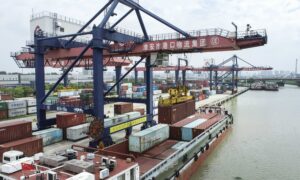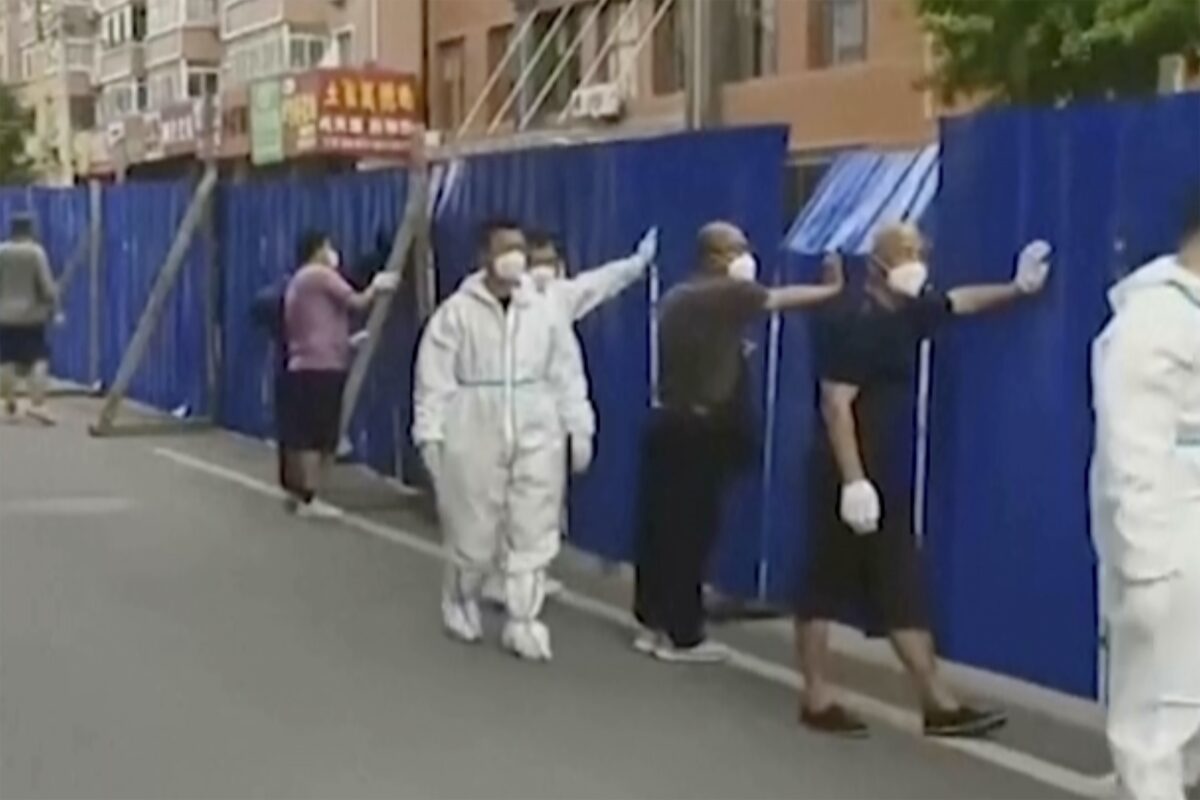China to Miss GDP Growth Target, Recession Possible: Experts
CommentaryThe Chinese economy is still struggling with ongoing lockdowns, uneven export growth, and U.S. rate hikes. Experts believe recession or stagflation may be imminent. Forecasts of 1 percent GDP growth fell short in the second quarter as the GDP only reached 0.4 percent. Retail sales were down 11 percent in April, leaving them 0.7 percent below last year for the first six months of the year. Car sales were down 10 percent during the second quarter while the service sector was down 0.4 percent, and youth unemployment reached 19.3 percent. Although the economy improved in June, growth slowed to 0.4 percent in the second quarter, which is the slowest pace since the pandemic started. For the first half of the year, growth was 2.5 percent compared to last year, a figure well-below Beijing’s growth target of 5.5 percent for the year. In May and June, Shanghai was under lockdown. This caused the city’s economy to contract 13.7 percent in the second quarter. Although COVID control measures in Shanghai and Beijing are easing, lockdowns are ongoing with some areas being shut down over a single case. Xi Jinping officially remains committed to his zero-COVID policy, which continues to wreak havoc on the economy. As of July 11, 31 cities that comprise a total of 17.5 percent of the country’s population and 25.5 percent of GDP were under full or partial lockdown. Outbound shipments rose 17.9 percent in June. Although China achieved a high trade surplus for the month, the rise in exports is expected to be temporary. The increase in exports may have been caused by a reduction in port congestion because of the reduction in domestic demand for imports. Import growth dropped to 1 percent in June and shows signs of further decline. Commodity imports were down with daily crude oil imports falling by 11 percent and coal imports falling 33 percent in June. A decline in commodity imports in one quarter is generally a leading indicator suggesting an overall decrease in industrial activity in the coming quarter. The rising cost of imported commodities and other inputs is escalating the cost of manufacturing. At the same time, inflation in the United States and Europe is decreasing overseas demand for Chinese goods. As a result, chief economist at Pinpoint Asset Management Zhiwei Zhang expects demand in the rest of the world to cool, in turn, suppressing Chinese exports in the second half of the year. A reduction in exports will result in slower economic growth and rising unemployment. Workers set up fences around a community under lockdown in Dandong city, in northeastern China’s Liaoning Province, on June 13, 2022. (Douyin@91244624 via AP) On the domestic front, the poor have become poorer in China as a result of lost income during lockdowns and rising cost of goods. According to a survey by the Beijing Social Work Development Center for Facilitators, 73 percent of respondents reported that their income had decreased during lockdowns. Both the middle and upper classes, by contrast, increased their savings, with household savings increasing $1.5 trillion in the first half of 2022. People are hesitant to part with their money when they are uncertain about future lockdowns. The rich, who can afford to spend, are another story. The sale of luxury goods is up, while the sales of staples and common consumer goods are in decline. Overall retail sales were down 1.5 percent in June. Housing demand is down and is expected to decline further as the population ages and the availability of mortgage funds declines. Investment in property development was down 9.4 percent at the end of June. Additionally, new housing contracts are an indicator of the expectations of the middle class. Their unwillingness to commit to the purchase of a new home suggests that they are pessimistic about the economic outlook. Brokerage giant Beike, owner and operator of Lianjia, one of China’s largest housing brokerages, predicts a decline in new housing demand by 2.5 percent per year through 2035. As real-estate related industries account for over 25 percent of the economy, slowdown in new housing development will send ripples throughout the entire economy. Despite declines in economic activity, Beijing is still aiming for a growth target of 5.5 percent, but Goldman cut their China growth forecast to 3.3 percent for the year. The median forecast for China’s GDP growth across financial institutions is 4 percent. In June, China experienced only modest, but growing, inflation of 2.5 percent. This is up from 2.1 percent in May. The overall unemployment rate of 4.8 percent is also not terribly alarming. However, with youth unemployment at a staggering level, rising import prices, and an expectation of declining exports, China may find itself facing a recession or stagflation in the near future. If stagflation occurs, experts expect China to be hit harder than many other countries because Chinese companies are so heavily leveraged. They represent 31 perce

Commentary
The Chinese economy is still struggling with ongoing lockdowns, uneven export growth, and U.S. rate hikes. Experts believe recession or stagflation may be imminent.
Forecasts of 1 percent GDP growth fell short in the second quarter as the GDP only reached 0.4 percent. Retail sales were down 11 percent in April, leaving them 0.7 percent below last year for the first six months of the year. Car sales were down 10 percent during the second quarter while the service sector was down 0.4 percent, and youth unemployment reached 19.3 percent. Although the economy improved in June, growth slowed to 0.4 percent in the second quarter, which is the slowest pace since the pandemic started. For the first half of the year, growth was 2.5 percent compared to last year, a figure well-below Beijing’s growth target of 5.5 percent for the year.
In May and June, Shanghai was under lockdown. This caused the city’s economy to contract 13.7 percent in the second quarter. Although COVID control measures in Shanghai and Beijing are easing, lockdowns are ongoing with some areas being shut down over a single case. Xi Jinping officially remains committed to his zero-COVID policy, which continues to wreak havoc on the economy. As of July 11, 31 cities that comprise a total of 17.5 percent of the country’s population and 25.5 percent of GDP were under full or partial lockdown.
Outbound shipments rose 17.9 percent in June. Although China achieved a high trade surplus for the month, the rise in exports is expected to be temporary. The increase in exports may have been caused by a reduction in port congestion because of the reduction in domestic demand for imports. Import growth dropped to 1 percent in June and shows signs of further decline. Commodity imports were down with daily crude oil imports falling by 11 percent and coal imports falling 33 percent in June. A decline in commodity imports in one quarter is generally a leading indicator suggesting an overall decrease in industrial activity in the coming quarter.
The rising cost of imported commodities and other inputs is escalating the cost of manufacturing. At the same time, inflation in the United States and Europe is decreasing overseas demand for Chinese goods. As a result, chief economist at Pinpoint Asset Management Zhiwei Zhang expects demand in the rest of the world to cool, in turn, suppressing Chinese exports in the second half of the year. A reduction in exports will result in slower economic growth and rising unemployment.

On the domestic front, the poor have become poorer in China as a result of lost income during lockdowns and rising cost of goods. According to a survey by the Beijing Social Work Development Center for Facilitators, 73 percent of respondents reported that their income had decreased during lockdowns. Both the middle and upper classes, by contrast, increased their savings, with household savings increasing $1.5 trillion in the first half of 2022. People are hesitant to part with their money when they are uncertain about future lockdowns. The rich, who can afford to spend, are another story. The sale of luxury goods is up, while the sales of staples and common consumer goods are in decline. Overall retail sales were down 1.5 percent in June.
Housing demand is down and is expected to decline further as the population ages and the availability of mortgage funds declines. Investment in property development was down 9.4 percent at the end of June. Additionally, new housing contracts are an indicator of the expectations of the middle class. Their unwillingness to commit to the purchase of a new home suggests that they are pessimistic about the economic outlook.
Brokerage giant Beike, owner and operator of Lianjia, one of China’s largest housing brokerages, predicts a decline in new housing demand by 2.5 percent per year through 2035. As real-estate related industries account for over 25 percent of the economy, slowdown in new housing development will send ripples throughout the entire economy.
Despite declines in economic activity, Beijing is still aiming for a growth target of 5.5 percent, but Goldman cut their China growth forecast to 3.3 percent for the year. The median forecast for China’s GDP growth across financial institutions is 4 percent.
In June, China experienced only modest, but growing, inflation of 2.5 percent. This is up from 2.1 percent in May. The overall unemployment rate of 4.8 percent is also not terribly alarming. However, with youth unemployment at a staggering level, rising import prices, and an expectation of declining exports, China may find itself facing a recession or stagflation in the near future.
If stagflation occurs, experts expect China to be hit harder than many other countries because Chinese companies are so heavily leveraged. They represent 31 percent of global corporate debt. The risk of Chinese corporate defaults has increased to 22 percent due to high amounts of debt and decreasing revenue prospects.
Views expressed in this article are the opinions of the author and do not necessarily reflect the views of The Epoch Times.












